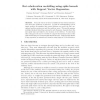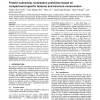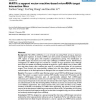383 search results - page 14 / 77 » Support Vector Training of Protein Alignment Models |
ESANN
2007
13 years 9 months ago
2007
Abstract. From the echoes of their vocalisations bats extract information about the positions of reflectors. To gain an understanding of how target position is translated into neu...
CVPR
2008
IEEE
14 years 9 months ago
2008
IEEE
We present a random field based model for stereo vision with explicit occlusion labeling in a probabilistic framework. The model employs non-parametric cost functions that can be ...
BMCBI
2007
13 years 7 months ago
2007
Motivation: Protein subcellular localization is crucial for genome annotation, protein function prediction, and drug discovery. However, since determining subcellular localization...
BMCBI
2008
13 years 7 months ago
2008
Background: MicroRNAs (miRNAs) are a set of small non-coding RNAs serving as important negative gene regulators. In animals, miRNAs turn down protein translation by binding to the...
BMCBI
2008
13 years 7 months ago
2008
Background: Gene Ontology (GO) annotation, which describes the function of genes and gene products across species, has recently been used to predict protein subcellular and subnuc...




